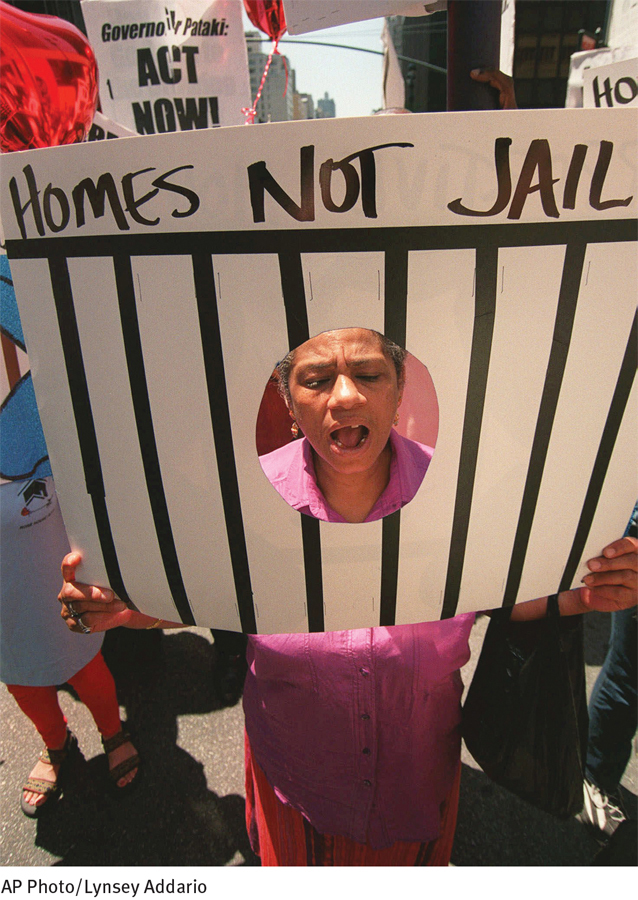15.6 PUTTING IT...together
An Important Lesson

After years of frustration and failure, clinicians now have an arsenal of weapons to use against schizophrenia and other disorders marked by psychosis—
Working with schizophrenia and other severe disorders has taught therapists an important lesson: no matter how compelling the evidence for biological causation may be, a strictly biological approach to the treatment of psychological disorders is a mistake more often than not. Largely on the basis of biological discoveries and pharmacological advances, hundreds of thousands of patients with schizophrenia and other severe mental disorders were released to their communities in the 1960s. Little attention was paid to their psychological and sociocultural needs, and many have been trapped in their pathology ever since. Clinicians must remember this lesson, especially in today’s climate, when managed care and government priorities often promote medication as the sole treatment for psychological problems.
When the pioneering clinical researcher Emil Kraepelin described schizophrenia at the end of the nineteenth century, he estimated that only 13 percent of its victims ever improved. Today, even with shortages in community care, many more people with schizophrenia—
BETWEEN THE LINES
Schizophrenia and Jail
There are more people with schizophrenia and other severe mental disorders in jails and prisons than there are in all hospitals and other treatment facilities.
People with severe mental disorders account for around 20 percent of the jail populations in the United States.
Inmates in jails and prisons have rates of schizophrenia that are four times higher than that of the general public.
Chicago’s Cook County Jail, where several thousand of the inmates require daily mental health services, is now in effect the largest mental institution in the United States.
(Pruchno, 2014; Balassone, 2011; Steadman et al., 2009; Morrissey & Cuddeback, 2008; Peters et al., 2008)
SUMMING UP
OVERVIEW OF TREATMENT For years, all efforts to treat schizophrenia brought only frustration. Schizophrenia is still difficult to treat, but today’s therapies are more successful than those of the past. p. 494
PAST INSTITUTIONAL CARE For more than half of the twentieth century, the main treatment for schizophrenia and other severe mental disorders was institutionalization and custodial care. Because patients failed to respond to traditional therapies, they were usually placed in overcrowded public institutions (state hospitals in the United States), typically in back wards where the primary goal was to maintain and restrain them. Between 1845 and 1955 the number of state hospitals and mental patients rose steadily, while the quality of care declined. pp. 495–
497 Page 517IMPROVED INSTITUTIONAL CARE In the 1950s, two in-
hospital approaches were developed, milieu therapy and token economy programs. They often brought improvement and particularly helped patients to care for themselves and feel better about themselves. pp. 497– 500 ANTIPSYCHOTIC DRUGS The discovery of antipsychotic drugs in the 1950s revolutionized the treatment of schizophrenia and other disorders marked by psychosis. Today they are almost always a part of treatment. Theorists believe that the first generation of antipsychotic drugs operate by reducing excessive dopamine activity in the brain. These “conventional” antipsychotic drugs reduce the positive symptoms of schizophrenia more completely, or more quickly, than the negative symptoms.
The conventional antipsychotic drugs can also produce dramatic unwanted effects, particularly movement abnormalities called extrapyramidal effects, which include Parkinsonian and related symptoms, neuroleptic malignant syndrome, and tardive dyskinesia. More than 10 percent of the people who take conventional antipsychotic drugs for an extended time develop tardive dyskinesia, an syndrome that can be difficult or impossible to eliminate, even when the drugs are stopped. Recently, atypical, or second-
generation, antipsychotic drugs (such as clozapine, risperidone, and olanzapine) have been developed; these seem to be more effective than the conventional drugs and to cause fewer or no extrapyramidal effects. pp. 500–504 PSYCHOTHERAPY Psychotherapy is often employed successfully in combination with antipsychotic drugs. Helpful forms include cognitive-
behavioral therapy, family therapy, and social therapy. Family support groups and family psychoeducational programs are also growing in number. pp. 505–509 THE COMMUNITY APPROACH A community approach to the treatment of schizophrenia and other severe mental disorders began in the 1960s, when a policy of deinstitutionalization in the United States brought about a mass exodus of hundreds of thousands of patients from state institutions into the community. Among the key elements of effective community care programs are coordination of patient services by a community mental health center, short-
term hospitalization (followed by aftercare), day centers, halfway houses, occupational training and support, and case management.Unfortunately, the quality and funding of community care for people with schizophrenia and other severe disorders have been inadequate throughout the United States, often resulting in a “revolving door” pattern. One consequence is that many people with such disorders are now homeless or in jail. Still others live in nursing homes or rest homes where they do not receive effective treatment, and many live in boardinghouses or single-
room- occupancy hotels. pp. 509– 514 THE PROMISE OF COMMUNITY TREATMENT The potential of proper community care to help people recovering from schizophrenia and other severe disorders continues to capture the interest of clinicians and policy makers. One major development has been the formation of national interest groups that are successfully promoting community treatment for people with these disorders. pp. 514–
516
Visit LaunchPad

www.macmillanhighered.com/